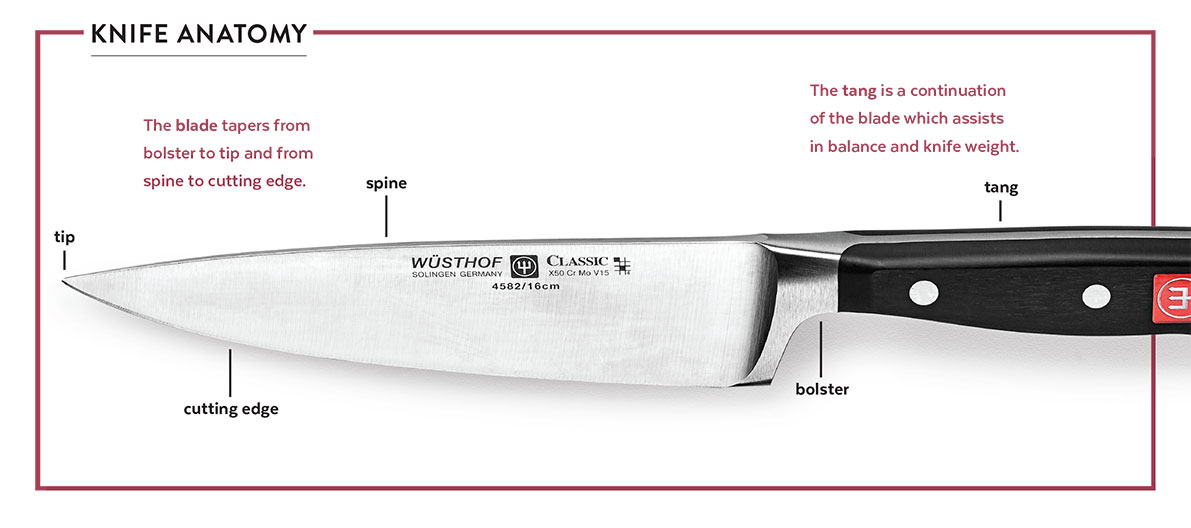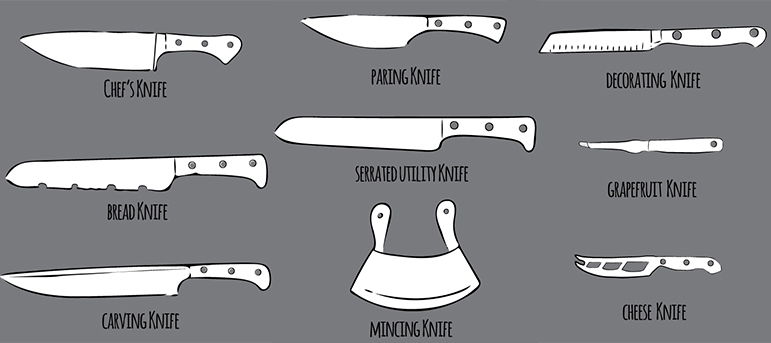I’ve spent years cooking in busy kitchens and testing knives at home. I know how fast a great blade can turn prep from a chore into flow. If you want to know how to choose a chef knife, start with fit and function, not hype. The right knife should suit your hand, your cutting style, and your routine. In this guide, you’ll learn what matters, what does not, and how to pick a chef knife you will love for years.

Page Contents
ToggleWhat Makes A Great Chef Knife
A chef knife is your everyday tool. It should slice, dice, and chop without strain. Focus on steel, shape, balance, and handle comfort. These four pillars drive performance and safety.
In my work, the best knives share a few traits. They feel stable, bite into food with little effort, and stay sharp long enough between touch-ups. They also clean up fast and resist rust under normal care.
Use these quick checks:
- Does it feel secure in your pinch grip near the bolster.
- Does the blade track straight through a carrot without twisting.
- Can you rock and push-cut with equal ease.

Blade Length And Shape
For most home cooks, 8 inches is the sweet spot. It is long enough for melons and short enough for herbs. If you cook big batches or large proteins, try 9 to 10 inches. If your space is tight, a 6-inch can work, but it limits you.
Blade shapes vary. German-style knives have a bigger belly for rocking. Japanese-style gyutos are slimmer with a flatter edge for push cuts. Santokus are shorter with a flat profile and a sheep’s foot tip. Pick what matches your style:
- Rocking motion often pairs with German curves.
- Push and pull cuts pair with flatter gyutos or santokus.
- Fine tip work is easier with a pointed gyuto.

Steel Basics: Hardness, Durability, And Care
Steel is a trade-off. Harder steels (often higher HRC) keep a sharp edge longer but can chip if misused. Softer steels are tougher and easier to sharpen but dull faster. Many Western knives sit around mid-50s HRC. Many Japanese knives are higher, often 60 and above.
You will see stainless and carbon. Stainless resists rust and stains. Carbon sharpens fast and feels “sticky” on the board, but it will patina and can rust. Powder steels can offer high hardness and fine grain with better toughness, at a higher price.
What this means in real life:
- If you cook daily and do light prep, stainless at medium hardness is great.
- If you love razor edges and do careful board work, harder Japanese steel shines.
- If you are new to care, avoid reactive carbon until you build habits.

Grind, Edge, And Thickness
Edge geometry affects how the knife moves through food. Thin behind the edge cuts with less force. A thicker spine adds stability for heavy work. Many chef knives have a V-edge. Some Japanese knives use a more acute angle for bite. Single-bevel blades are niche and need skill.
Ask these questions:
- Is the blade thin near the edge for low resistance.
- Does the knife wedge in hard veg like sweet potatoes.
- Does the tip feel precise for onions and garlic.
From my tests, a thin convex grind gives the best of both worlds. It glides yet stays stable. But even a modest factory grind can feel great once you sharpen it well.
Handle And Ergonomics
Handles come in two main styles. Western handles are contoured and often full tang. Wa handles (Japanese) are lighter and straight. Neither is better for all users. Comfort is king.
Try a pinch grip. Your thumb and index finger pinch the blade in front of the bolster. This should feel natural. The handle should not create hot spots on your palm. Materials vary from wood to resin to micarta. I like grippy textures that stay safe when wet.
Watch for:
- Smooth transitions with no sharp edges at the bolster.
- A handle shape that guides your hand without forcing it.
- Enough clearance so knuckles do not hit the board.
Balance And Weight
Weight affects control and fatigue. A heavier German knife can power through squash. A lighter Japanese gyuto dances through herbs and fish. Balance point matters. Many cooks like it at or just ahead of the bolster for a pinch grip.
If your wrist gets sore, go lighter. If you fight through dense food, try a bit more mass. I keep one nimble gyuto for daily prep and one heavier blade for tough jobs. That combo covers all bases.
Fit And Finish: The Hidden Quality
Small details add up. Look for even grinds, straight spines, and flush rivets. The heel should not have burrs. The spine and choil should be eased so they do not rub your finger.
Quality control varies by maker and line. Inspect the knife under light. Sight down the edge like a straight line. Check for warps. Run a cotton pad along the spine to detect snags. These checks take one minute and can save months of regret.
Care, Sharpening, And Longevity
A sharp knife is a safe knife. Honing rods help align the edge. But they do not replace sharpening. Learn to use a whetstone. A basic 1000/3000 or 1000/6000 stone covers most needs. Keep a steady angle. Light pressure wins.
Wash by hand. Dry at once. Do not soak. Use a wood or quality plastic board. Store on a magnetic strip or in a sheath. Avoid glass and granite. Edge life depends on use and care more than brand. With good habits, even mid-range knives feel amazing for years.
Quick care rules:
- No dishwashers, ever.
- No twisting through bones or frozen food.
- Wipe during prep to avoid acidic stains.
Budget And Value: Where To Spend
Price does not equal performance for every cook. Under 100 dollars, you can get a solid stainless Western knife that sharpens well. In the 100 to 200 range, you get better steel, grinds, and fit. Above 200, you pay for premium steel, hand work, and brand.
If you sharpen, a budget blade can feel premium. If you never sharpen, pay for tougher steel and pro sharpening once or twice a year. Best value lives where steel, grind, and comfort meet your habits.
Japanese vs. German Knives: Which One Fits You
German knives are robust, curved, and thicker. They favor rocking and rough tasks. Japanese gyutos are thinner with keener edges. They favor push cuts and precision. Neither is better. They are tools for styles.
I tell new cooks to pick based on motion:
- Rocking and mincing all day: German profile.
- Straight push cuts and fine tip work: Japanese gyuto.
- Short counters or smaller hands: Santoku can be ideal.
Try-Before-You-Buy Checklist
Use this list at a store or when unboxing:
– Grip: Pinch the blade. Does it feel stable and natural.
– Balance: Where does it pivot on your finger. Ahead of the bolster is great for control.
– Paper test: Light slice through a sheet. It should glide, not snag.
– Carrot test: Straight cuts without wedging or steering.
– Board feel: The tip should meet the board without digging in early.
If shopping online, check return policies. Try it for a week with safe packaging kept. A real test beats spec sheets.
Evidence And Expert Notes
Industry data shows that edge retention rises with hardness to a point, but toughness drops as hardness climbs. Real kitchen use also dulls edges by micro-roll, not only metal loss. Studies of cutting forces confirm thinner edges reduce effort, but they need better technique and boards to avoid chips. These facts match what chefs find in daily prep.
What this means for you:
- Pick hardness and thinness suited to your cutting style and board.
- Keep angles modest, around 15 to 20 degrees per side for most stainless.
- Use a soft board to protect your edge.
Frequently Asked Questions
What Size Chef Knife Should I Buy
Most home cooks do best with an 8-inch blade. It balances reach and control. Go longer if you prep large items often.
Is A Japanese Or German Knife Better
Neither is better for all tasks. Japanese knives are thinner and sharper. German knives are tougher and better for rocking and heavy work.
How Often Should I Sharpen My Chef Knife
For daily use, sharpen every 2 to 3 months. Hone lightly every few sessions. Timing depends on your board and technique.
What Cutting Board Is Best For My Knife
Use end-grain wood or quality plastic. Avoid glass, marble, or bamboo that is too hard. A soft board preserves the edge.
Can I Put My Chef Knife In The Dishwasher
No. Heat, detergent, and movement can damage the edge and handle. Wash by hand and dry right away.
What’s The Best Steel For Beginners
Stainless with medium hardness is easiest. It resists rust and chips less. It still gets very sharp with basic stones.
How Do I Know If The Knife Fits My Hand
Use a pinch grip. The handle should not cause hot spots. Your wrist should feel relaxed after a few minutes of chopping.
Final Takeaway
Choosing a chef knife is about fit, not fame. Pick the length and shape that match your cuts. Choose steel and weight that suit your care habits. Check balance, comfort, and edge feel. Then build a simple care routine and keep it sharp.
I’ve made all the mistakes: buying too hard, too heavy, too pretty to use. The knife I reach for now feels natural, stays sharp long enough, and cleans fast. That is success you can feel each time you cook.
Ready to find your match. Use the checklist, try a few, and trust your hand. If you want more guides, subscribe and leave a comment with your short list. I’m happy to help you compare options.
Watch This Video on how to choose a chef knife
Disclosure: As an Amazon Associate, I may earn from qualifying purchases at no extra cost to you. Amazon and the Amazon logo are trademarks of Amazon.com, Inc, or its affiliates.

